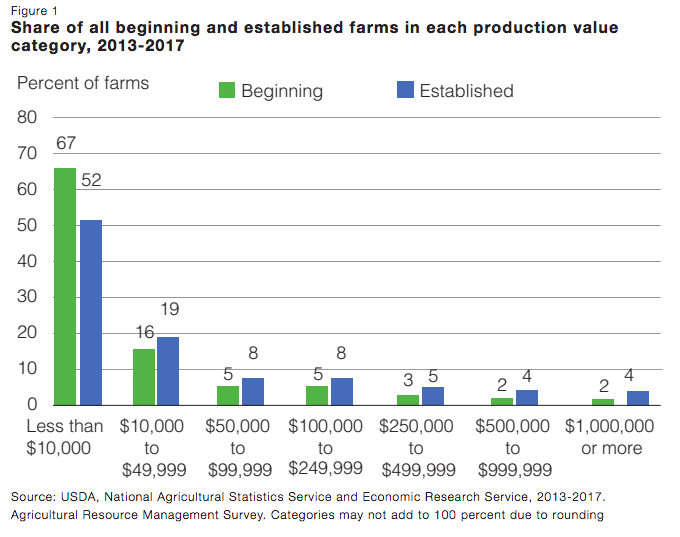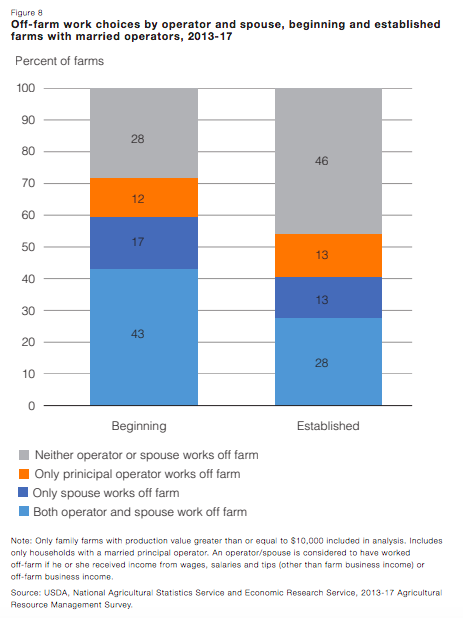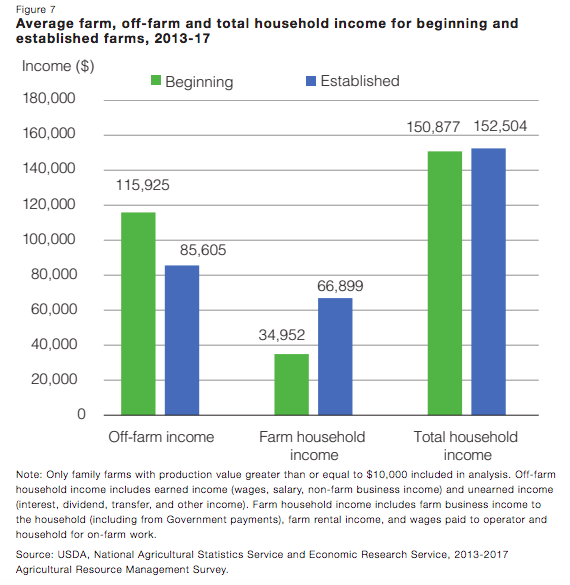
The Economic Research Service (ERS) is the primary federal research agency for economic and statistical information about our country’s food and farm sector and related policies within the U.S. Department of Agriculture (USDA). ERS publications and research findings provide essential data and analysis that helps identify trends and inform policymakers and other stakeholders about the economic impacts of federal agriculture policy.
As a statistical research agency, ERS has access to invaluable data across a wide array of food system topics that sometimes no other agency has. This means that ERS reports and publications can often be the sole source of credible and comprehensive data and analysis on a given topic related to our country’s food and agriculture system. ERS sometimes is the only agency doing research on specific or emerging topics, such as identifying demographic and economic trends across agricultural producers in the U.S. – including the next generation of farmers.
The agency has been publishing data and analyses on beginning farmers and ranchers since 2009, and recently released a new report that provides important updates on the state of new farmers and highlights the value of this important agency – which is being targeted for funding cuts and downsizing through a short-sighted and disastrous relocation proposed by USDA (more on that below).
This post provides a summary of ERS’s new report on beginning farmers.
Report Overview
An Overview of Beginning Farms and Farmers is a new economic brief published last month by ERS. The report uses data collected in USDA’s Agricultural Resource Management Survey (ARMS) between 2013 and 2017 to describe structural and economic characteristics of beginning farms and farmers and the differences between those operations and more established farms. The report found that, between 2013 and 2017, beginning farms and ranches accounted for 17 percent of all farming and ranching operations and 8 percent of agricultural production in the U.S. Analyzing data and trends on beginning producers is extremely important, considering that our nation’s farmers are aging and the future of American agriculture depends on the new generation of producers.
Some of the report’s key findings include:
- Beginning farms are generally smaller and younger than established farms
- Most beginning farms specialize in beef cattle and row crops
- Beginning farmers are more likely to work off-farm and are more reliant on off-farm income
- Fewer beginning farmers receive government payments
- Beginning farmers have higher debt-to-asset ratios
- Beginning farmers are more likely to receive financing from FSA
Most Beginners Start Out Small
Compared to more established operations, beginning farms tend to be smaller and earn less farm income, at least when starting out. It is important to note that ERS uses sales volume (rather than acreage) to describe farm size. More than two-thirds of beginning farms and ranches produce less than $10,000 in farm output, which reflects a similar structure of more established farms.
However, while most beginning farms and ranches are small, the majority of agricultural sales generated by new farmers comes from larger operations with annual sales of at least $1,000,000. Only 2 percent of all beginning farms and ranches fall within this category, though, which means that production is concentrated within large beginning operations, mirroring the structure and production distribution of more established farms and ranches across the country.

For this report, the scope of the analysis was limited to operations with $10,000 or more in sales, meaning that two thirds of beginning operations are not considered and included in many parts of the report. Beginning farmers could be starting their operations part time or at a much smaller scale, so the analysis done by ERS applies to commercial beginning operations.
ERS found that beginning farmers not only tend to have lower annual sales, but also earn less on average than more established farms. Beginning and established farms were compared based on gross cash farm income (GCFI), which is the farm’s annual income before expenses, and includes cash receipts, farm-related income, and farm program payments. For operations with at least $10,000 in sales, only 12 percent of new farmers earned more than $350,000 in GCFI, compared to 22 percent of established farms within the same category of production. Additionally, the average farm household income for beginning operations was almost $32,000 less than for established farms.
Beginners Focus on Livestock
Similar to established farms, most beginning operations specialize in beef cattle and cash grains and oilseeds. Although beef cattle and row crops are the most common specializations for beginning operations, beginning farms and ranches account for only 10 percent of all beef operations and 12 percent of all cash grains and oilseeds operations. Beginning farmers and ranchers represent a larger share of producers in poultry and other livestock (e.g., sheep, goats, aquaculture, and other), accounting for 19 percent of farms in each of these specializations. For high-value crops, beginning operations account for a little over 7 percent of farms.
Off-Farm Jobs Are Key
Beginning farmers are also more likely to work off-farm and rely more on off-farm income. In 2017, 67 percent of beginning farmers worked off-farm, whereas only 45 percent of established farmers worked off-farm. Beginning farmers were more likely to work full-time and part-time off-farm than established farmers. Not surprisingly, they tend to be younger and are less likely to be retired from farming than more established operators.

Established and beginning operations earned almost the same total household income, but off-farm income for beginning operations represents a greater share (77 percent) of total income compared to established operations (56 percent).

Another income stream for beginning farmers are payments through USDA farm programs. And while a smaller share of beginning farms (one-third) receive agricultural payments than established farms (41 percent), the payments represent a larger share of farm income for those beginning farms receiving them. Agricultural payments represented 20 percent of net cash farm income (NCFI) for beginning farms, whereas for established farms, they represented only 14 percent.
Beginners are Much Younger on Average
On average, beginning farmers are several decades younger than more established operations: the average beginning farmer (principal operator) is 43 compared to 63 for established operations. Within established operations, 8 percent of farms and ranches were classified as retirement farms, compared to only 4 percent of beginning operations, which coincides with the fact that beginning farmers tend to be much younger than established farmers.
Beginners Generate Less Wealth, More Debt
Since beginning farmers are younger on average than more established farmers, most beginning farmers have fewer years to accrue wealth. Generally, beginning farms have less wealth and a higher debt-to-asset ratio than more established farms, which is consistent with the fact that beginning farms tend to be smaller operations and have younger operators. On average, a beginning farm household has about half the net worth (both farm and non-farm) of an average established farm.
Both beginning and established farms have farm business debt, although a larger share of beginning operations have debt than established operations. Both beginning and established farmers with farm business debt are more likely to borrow from commercial banks than other lending institutions. However, more established farmers relied more heavily on Farm Credit System institutions for lending, whereas beginning farmers were more likely to obtain loans from the Farm Service Agency (FSA), pointing to the positive engagement impact of loan programs operated by FSA that target beginning farmers.
Uncertain Future for ERS
This report is just one example of the critical research and insights that ERS develops and provides to food and farm stakeholders and policymakers across the country. USDA’s proposed relocation of ERS, along with the National Institute of Food and Agriculture (NIFA), threatens the continuation of many publications on topics ranging from food security and beginning farmers to global trade and corporate consolidation, and will most likely delay the distribution of funding for food and agricultural research.
Because of the uprooting of these core research agencies to Kansas City, a mass exodus has already taken place at both ERS and NIFA, weakening our national research infrastructure. Reportedly, only 7 percent of the 280 ERS employees agreed to move to Kansas City, and 44 will temporarily continue to work in the Washington, D.C. office. However, many others have already left – 88 staff members left the agency and another 50 staffers retired – leaving the agency massively understaffed and with an irreparable loss of invaluable expertise and knowledge in the world of agricultural economic research.
The National Sustainable Agriculture Coalition (NSAC) has previously highlighted serious concerns regarding the relocation of ERS and NIFA, and has urged Congress to halt this misguided decision. The House included in its fiscal year (FY) 2020 spending bill language that would block plans to relocate both agencies from the nation’s capital, but the Senate spending bill did nothing to stop the relocation and provided $25 million to support the ill-conceived plans.
As we move into conference for appropriations for FY 2020, NSAC will continue to urge Congress to act with the utmost urgency and uphold the House’s language blocking this relocation to prevent further damage from being inflicted on the agencies and on our national agricultural research infrastructure.

